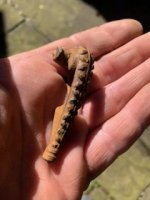Colombiapictures
Full Member
- May 7, 2010
- 123
- 71
On every ship there was (and still is today) a person responsible for the stowing of the cargo.(Supercargo)
On sailing ships specially, but still valid on every ship today, it is very important to stow the cargo is a specific order.
The heaviest cargo goes lowest. This would be the bulk of the silver. It should be evenly distributed along the keel. However, sometimes the Supercargo goofed up, like on the Atocha, where the silver and copper was heaped up. When the ship hit the reef and sank it damaged the bottom. A short time later in the second hurricane, the movement of the waves and swells finished breaking the lower hull and the ship separated. The bottom part with the silver bars and chests and copper bars stayed where it had sunk. (The Mother Lode)The whole upper part drifted away and got stuck on a shallower area. There it dropped the bronze cannon 19? and then, lighter, continued, drifting and hitting the reefs and sand dunes along the way.
At "The bank of Spain" several chests of silver coins dropped off. Obviously these chests of coins were not stored at the same place like the main treasure. They must have belonged to private merchants. Merchants had their goods stowed in a different part from the "Kings Part"
On the "Patch Reef" there was gold and jewelry that looked as if it had belonged to a passenger.
Bulky boxes like passenger goods went higher up, because of lesser weight and more fragility. Rich passengers had their main cargo in the merchant cargo hold, but had also their "sea chests" with very special valuables in their cabins.
It is very important to take accurate note of every find. It is the finds that tell the story. So it is that near the "Mother Lode" there were the contents of many chests of mixed goods, including the emeralds, obviously belonging to the passengers and merchants. It looks as if there was a complete hold that broke up there.
Did the stern castle separate from the upper hull? Probably only later. The whole upper hull with it's cannon drifted to the edge of the channel. Thinking back, it was the lack of ballast near the earlier finds that was a strong indicator that the bottom of the ship had not been found yet.
The Atocha cargo manifest is fairly complete. It would be interesting to verify every small detail in it to get a better picture, combined with the finds, of how the ship broke up.
Probably the story of the "Maravillas" goes the same way.
On sailing ships specially, but still valid on every ship today, it is very important to stow the cargo is a specific order.
The heaviest cargo goes lowest. This would be the bulk of the silver. It should be evenly distributed along the keel. However, sometimes the Supercargo goofed up, like on the Atocha, where the silver and copper was heaped up. When the ship hit the reef and sank it damaged the bottom. A short time later in the second hurricane, the movement of the waves and swells finished breaking the lower hull and the ship separated. The bottom part with the silver bars and chests and copper bars stayed where it had sunk. (The Mother Lode)The whole upper part drifted away and got stuck on a shallower area. There it dropped the bronze cannon 19? and then, lighter, continued, drifting and hitting the reefs and sand dunes along the way.
At "The bank of Spain" several chests of silver coins dropped off. Obviously these chests of coins were not stored at the same place like the main treasure. They must have belonged to private merchants. Merchants had their goods stowed in a different part from the "Kings Part"
On the "Patch Reef" there was gold and jewelry that looked as if it had belonged to a passenger.
Bulky boxes like passenger goods went higher up, because of lesser weight and more fragility. Rich passengers had their main cargo in the merchant cargo hold, but had also their "sea chests" with very special valuables in their cabins.
It is very important to take accurate note of every find. It is the finds that tell the story. So it is that near the "Mother Lode" there were the contents of many chests of mixed goods, including the emeralds, obviously belonging to the passengers and merchants. It looks as if there was a complete hold that broke up there.
Did the stern castle separate from the upper hull? Probably only later. The whole upper hull with it's cannon drifted to the edge of the channel. Thinking back, it was the lack of ballast near the earlier finds that was a strong indicator that the bottom of the ship had not been found yet.
The Atocha cargo manifest is fairly complete. It would be interesting to verify every small detail in it to get a better picture, combined with the finds, of how the ship broke up.
Probably the story of the "Maravillas" goes the same way.




